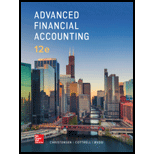
EBK ADVANCED FINANCIAL ACCOUNTING
12th Edition
ISBN: 9781260165104
Author: Christensen
Publisher: YUZU
expand_more
expand_more
format_list_bulleted
Question
Chapter 14, Problem 14.3.4E
To determine
Introduction: In 1934, the Securities and Exchange Act was established. The main purpose of this act is to regulate the United States securities market. It regulates only securities offered for public sale.
Form used by a company registered under the Securities and Exchange Act of 1934 to report a significant event affecting it.
Expert Solution & Answer
Want to see the full answer?
Check out a sample textbook solution
Students have asked these similar questions
I need assistance with this general accounting question using appropriate principles.
Can you help me solve this general accounting problem with the correct methodology?
There are different tools for analyzing the financial statements of a company, such as horizontal analysis, vertical analysis, ratios for measuring financial health and profitability, and so forth. Why do we need different tools for analyzing financial statements? Don't the numbers in the financial statements speak for themselves?
Chapter 14 Solutions
EBK ADVANCED FINANCIAL ACCOUNTING
Ch. 14 - Prob. 14.1QCh. 14 - Prob. 14.2QCh. 14 - Prob. 14.3QCh. 14 - Prob. 14.4QCh. 14 - Prob. 14.5QCh. 14 - Prob. 14.6QCh. 14 - Prob. 14.7QCh. 14 - Prob. 14.8QCh. 14 - Prob. 14.9QCh. 14 - Prob. 14.10Q
Ch. 14 - What type of items that specially involve the...Ch. 14 - Prob. 14.12QCh. 14 - Prob. 14.13QCh. 14 - What types of information must be disclosed in the...Ch. 14 - Prob. 14.15QCh. 14 - Prob. 14.1CCh. 14 - Prob. 14.7CCh. 14 - Prob. 14.8CCh. 14 - Prob. 14.1.1ECh. 14 - Prob. 14.1.2ECh. 14 - Organization Structure and Regulatory Authority of...Ch. 14 - Prob. 14.1.4ECh. 14 - Prob. 14.1.5ECh. 14 - Prob. 14.1.6ECh. 14 - Prob. 14.2.1ECh. 14 - Prob. 14.2.2ECh. 14 - Prob. 14.2.3ECh. 14 - Prob. 14.3.1ECh. 14 - Prob. 14.3.2ECh. 14 - Prob. 14.3.3ECh. 14 - Prob. 14.3.4ECh. 14 - Prob. 14.3.5ECh. 14 - Prob. 14.3.6ECh. 14 - Prob. 14.3.7ECh. 14 - Prob. 14.4.1ECh. 14 - Prob. 14.4.2ECh. 14 - Prob. 14.4.3ECh. 14 - Prob. 14.4.4ECh. 14 - Prob. 14.6.1ECh. 14 - Prob. 14.6.2ECh. 14 - Prob. 14.6.3ECh. 14 - Prob. 14.6.4ECh. 14 - Prob. 14.6.5ECh. 14 - Prob. 14.6.6E
Knowledge Booster
Similar questions
- Please help me solve this financial accounting question using the right financial principles.arrow_forwardSales made in fiscal 2025 for $50,000,000 include a 5-year warranty coverage. The estimated cost for warranty is expected to be 2% for each of the first 4 years and 5% for the last year. Determine how much warranty expense will be recorded in fiscal 2025. Question 2 options: $6,500,000 $4,000,000 $1,000,000 $5,000,000arrow_forwardAgree or disagree with the post Financial statements provide raw data, but without analysis, they lack meaningful insight. Different tools help uncover trends, assess financial health, and compare performance effectively. Horizontal analysis tracks changes over time, identifying growth patterns or declines. Vertical analysis expresses financial items as percentages of a base figure, making comparisons across companies easier. Like liquidity, profitability, and solvency measures, ratios offer critical efficiency, risk, and stability assessments. These tools translate numbers into actionable intelligence, helping businesses, investors, and analysts spot risks, make informed decisions, and drive strategic planning. Without them, financial statements can be overwhelming and lack clarity. Agree or disagree with the postarrow_forward
- A $100,000 5-year 6% bond is issued on January 1, 2026. The bond pays interest annually. The market rate is 7%. What is the selling price of the bonds, rounded to the nearest dollar? Question 6 options: $104,213 $95,900 $100,000 $4,100arrow_forwardA $100,000 5-year 6% bond is issued on January 1, 2026. The bond pays interest annually. The market rate is 7%. What is the selling price of the bonds, rounded to the nearest dollar? Question 6 options: $104,213 $95,900 $100,000 $4,100arrow_forwardDell Industries has a normal capacity of 30,000 direct labor hours. The company's variable costs are $45,000, and its fixed costs are $27,000 when operating at normal capacity. What is its standard manufacturing overhead rate per unit?arrow_forward
- Which statement about a "treasury shares" is correct? Question 10 options: These shares continue to have voting rights. These shares must be cancelled upon re-purchase. The company does not pay dividends on these shares. These shares are disclosed as issued and outstanding.arrow_forwardWhich statement best describes the accounting when a company cancels its own shares at an amount higher than the average share value? Question 9 options: Contributed surplus and retained earnings will be debited. Contributed surplus will be debited, thereby decreasing equity. Contributed surplus and retained earnings will be credited. Contributed surplus will be credited, thereby increasing equity.arrow_forwardWhich statement is correct? Question 8 options: A corporation need only pay dividends when it declares them to be payable. A company can avoid a cumulative dividend on preferred shares if it declares dividends on common shares. Dividends are never discretionary payments. Companies must pay the shareholders interest to compensate for the time value of money lost on the deferral of dividend payments. No entryarrow_forward
arrow_back_ios
SEE MORE QUESTIONS
arrow_forward_ios
Recommended textbooks for you
 Auditing: A Risk Based-Approach to Conducting a Q...AccountingISBN:9781305080577Author:Karla M Johnstone, Audrey A. Gramling, Larry E. RittenbergPublisher:South-Western College Pub
Auditing: A Risk Based-Approach to Conducting a Q...AccountingISBN:9781305080577Author:Karla M Johnstone, Audrey A. Gramling, Larry E. RittenbergPublisher:South-Western College Pub Cornerstones of Financial AccountingAccountingISBN:9781337690881Author:Jay Rich, Jeff JonesPublisher:Cengage Learning
Cornerstones of Financial AccountingAccountingISBN:9781337690881Author:Jay Rich, Jeff JonesPublisher:Cengage Learning Auditing: A Risk Based-Approach (MindTap Course L...AccountingISBN:9781337619455Author:Karla M Johnstone, Audrey A. Gramling, Larry E. RittenbergPublisher:Cengage Learning
Auditing: A Risk Based-Approach (MindTap Course L...AccountingISBN:9781337619455Author:Karla M Johnstone, Audrey A. Gramling, Larry E. RittenbergPublisher:Cengage Learning- Principles of Accounting Volume 1AccountingISBN:9781947172685Author:OpenStaxPublisher:OpenStax College

Auditing: A Risk Based-Approach to Conducting a Q...
Accounting
ISBN:9781305080577
Author:Karla M Johnstone, Audrey A. Gramling, Larry E. Rittenberg
Publisher:South-Western College Pub

Cornerstones of Financial Accounting
Accounting
ISBN:9781337690881
Author:Jay Rich, Jeff Jones
Publisher:Cengage Learning

Auditing: A Risk Based-Approach (MindTap Course L...
Accounting
ISBN:9781337619455
Author:Karla M Johnstone, Audrey A. Gramling, Larry E. Rittenberg
Publisher:Cengage Learning

Principles of Accounting Volume 1
Accounting
ISBN:9781947172685
Author:OpenStax
Publisher:OpenStax College